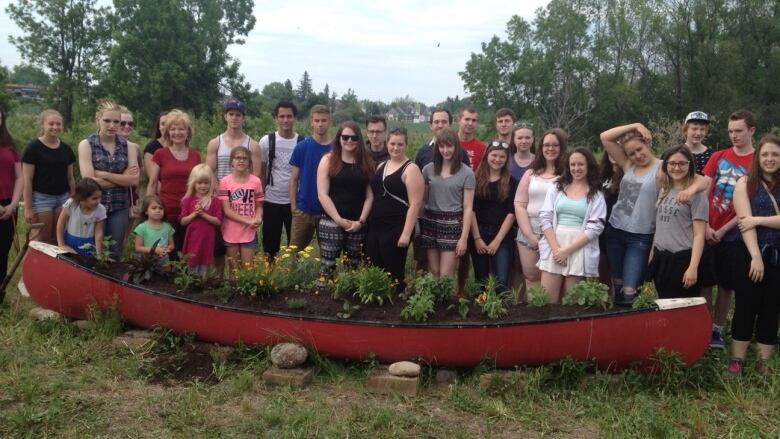Once a weapon, education is now key to reconciliation
Stories of Canada's native people need to be centre of education curriculum, Waterdown teacher says

Everything changed for me the moment I walked into the entrance of Brantford's Mohawk Institute Residential School called the "Mush Hole" by its survivors.
It was the smell that got to me. Thick and musty a heaviness that clung to you even after you left. I remember looking into a cupboard where young children had been locked for days on end as a form of punishment. I could still smell the sweat and urine, see the scratches made on the inside.
As I listened in horror to the testimonies told by survivors I realized that as an educator I had a responsibilityto take as many students as possible to bare witness to that place, as well as explore with my students what had happened in this country to allow such a program to exist.
- Education 'only way forward,' says Gov. Gen. David Johnston as TRC ends
- Truth and reconciliation: Looking back on a landmark week for Canada
The residential school program demonstrates how education was used as a tool to destroy culture. Now we must reverse this process and use the school system to integrate indigenous stories and our foundational treaty relationships into the everyday lives of non-indigenous Canadians.
When I became a teacher of Canadian history, I was very tentative about exploring the place of indigenous peoples in that history with my students. Resources were scarce and the curriculum did not ask us to dwell too much on the subject (fortunately, that has changed in Ontario).
For me, the history of the indigenous peoples was filled with names that were difficult to pronounce and an oral tradition that didn't fit well with my profession's book-centred and Euro-centric focus.
It wasn't until I learned from elders and knowledge keepers that a treaty was all about being inand respectinga relationship, that my perspective changed. Quite simply, I needed to understand that "treaty" was not a noun, but rather a verb.
Illegal soil
Last week the latest group of students from Waterdown District High School walked into the main entrance of the Mush Hole.
Their eyes lingered on the old wood paneling and copy of Stephen Harper's 2008 apology that hangs near where the office was once located.
As always, my friend and colleague Eugene Kahgee, from Saugeen First Nation, was there. His father was sent to the Mush Hole and could never bring himself to go back. My students were quiet as they walked through the rooms and saw the places where countless abuses occurred over the generations.
Leaving Brantford, we travelled to the New Credit Reserve to meet with Carolyn King. As part of the Mississaugas of the New Credit Nation's celebrations of the 2015 Toronto PanAm Parapan Games, Carolyn created the idea to establish canoe gardens that would link the reserve to the events across the golden horseshoe.
The gardens are filled with native plants, serving as tangible reminders of the indigenous identity of the land. My school had asked to host one of these gardens, and the students arrived in New Credit to collect the different plants that they would carry back home.
I was also given a bag of soil from the reserve an illegal act under the Trading with Indians section of the Indian Act. We did it to highlight that while outside companies strip resources from indigenous territories across the country, it remains illegal for a native person to gift me soil from their garden.
Canoe garden an education piece
Back in Waterdown,we stirred the illegal soil into our canoe garden, burying paper hearts in its earth, linking it to the hundreds of heart gardenscreated for the Truth and Reconciliation Commission that are dedicated to the thousands of children lost to the residential school program.
The garden will be maintained by the community as an active education piece, reminding people that they live in a treaty relationship with others.
Today we begin to change the history of Canada.- Justice Murray Sinclair
Our students lived their treaty relationship that day. Future generations of students will visit and tend to the garden planted on the eve of the TRC final report, learning about their partners on the land.
As I think about that day, watching my students planting and watering the plants gifted to them by the Mississaugas of the New Credit, Justice Murray Sinclair's words fill my heart: "Today we begin to change the history of Canada."
"Canoes were traditionally used for transportation, to allow movement and to connect people," explained Tyler Alexis, a student tasked with creating a description of the garden.
"This canoe needs to be seen in the same light. It is a symbol for all peoples. A symbol of progress that moves the conversation forward."
The relationships between Canada and indigenous peoples must be placed at the very centreof our provincial curricula. It is the key to reconciliation.
Nathan Tidridge is ahistory teacher at Waterdown District High School andthe author of The Queen at the Council Fire: The Treaty of Niagara, Reconciliation and the Dignified Crown in Canada (Dundurn Press, 2015). He lives in Waterdown, Ontario.












_(720p).jpg)


 OFFICIAL HD MUSIC VIDEO.jpg)
.jpg)



























































































